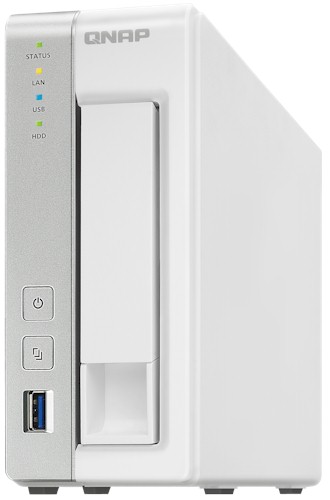
| At a glance | |
|---|---|
| Product | QNAP Turbo NAS (TS-131) [Website] |
| Summary | BYOD single bay Mindspeed-powered SATA NAS with Gigabit LAN, USB 3.0 and eSATA ports. |
| Pros | • iSCSI target support • USB 2.0, 3.0 and eSATA ports • Broad feature set |
| Cons | • USB backup problem with Startech dock |
Typical Price: $148 Buy From Amazon
Introduction
Many NAS manufacturers use a common operating system across their entire product line. If you’re looking for a low cost single drive NAS, that’s good news. With a common operating system, you get most, if not all the features of a manufacturer’s far more expensive NASes. Of course, with a single drive NAS, you won’t get the fault tolerance provided by RAID.
Earlier this year, we reviewed the QNAP TS-112P single drive Turbo NAS. Using QNAP’s category description, the TS-x12P is aimed at the SOHO/Home (entry level) market. This review will focus on the single drive TS-131 Turbo NAS, a member of the Work Group/SOHO/Home category (middle-end) NASes.
Compared to the TS-112P, the TS-131 represents a significant step up in performance and features for $40 more than the TS-112P. The TS-131 has a hot-swappable, removable tray that supports both 3.5″ and 2.5″ disks, dual-core processor with support for hardware encryption, three USB 3.0 ports and can act as a domain controller. The TS-112P doesn’t have a removable drive tray, supports only 3.5″ disks, has a single core Marvell processor and two USB 3.0 and 1 USB 2.0 ports. And, as we’ll see in the performance section of this review, the TS-131 provides quite a bump in performance.
QNAP uses common instruction manuals that cover multiple products. I wasn’t able to find callouts for the front and rear panels, but both are simple enough that you can easily identify the LED indicators and the ports in the panel views below.
The front panel has indicators for Status, LAN, USB and HDD. There’s a single USB 3.0 port, a USB copy button, and the power switch. Unlike the TS-112P, there’s not a status light for eSATA. The rear panel has a single Gigabit Ethernet port, two USB 3.0 ports, eSATA port, power connector and a Kensington security slot. Cooling is provided by a 5cm fan.
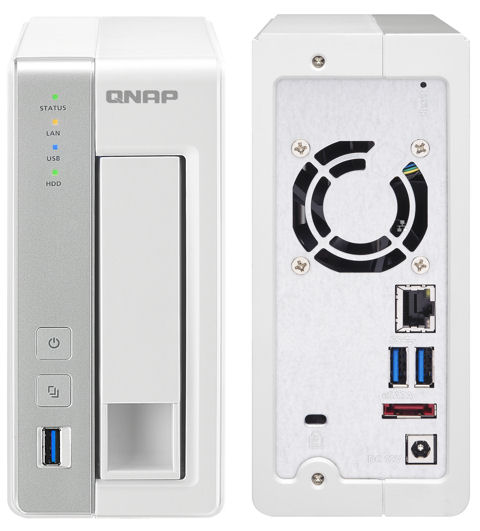
QNAP TS-131 front and rear panels
Inside
Below is the main board photo for the TS-131. In the center, you’ll note the Mindspeed Comcerto processor. (Note: Mindspeed was acquired by Freescale in 2014, but the processor is still marked Mindspeed.)
In the upper left corner you can see, from the top moving toward the bottom, the power connector, eSATA port, the two USB 3.0 ports and the Gigabit Ethernet port. To the right of the ports is the eSATA connector that connects to the disk. Along the lower right edge of the PCB are the LED indicators.
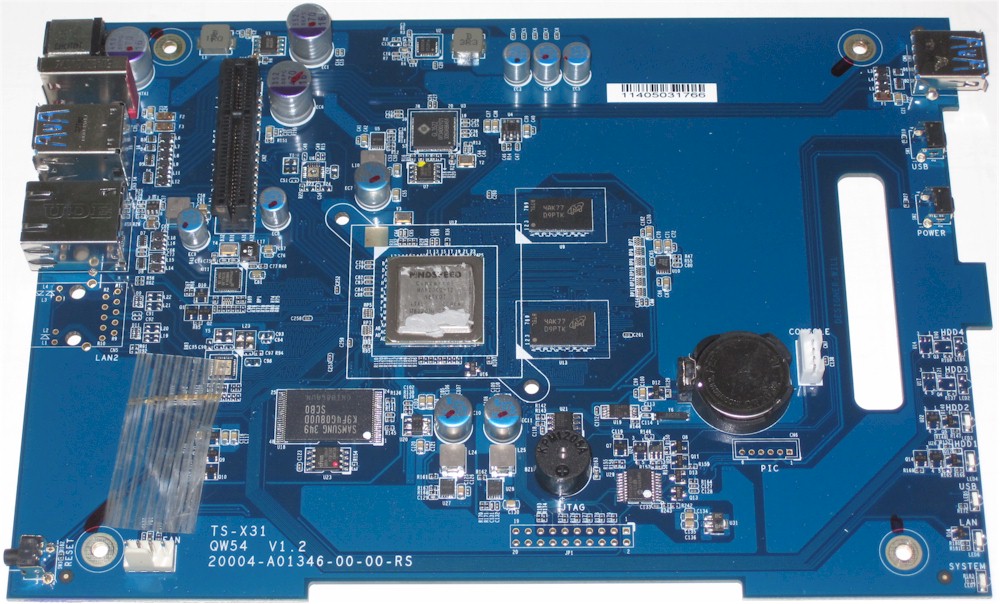
QNAP TS-131 PCB
Table 1 shows a comparison of key components for the TS-131 as well as the other two single bay NASes I’ll be using for comparison in the performance section of this review.
| QNAP TS-131 | QNAP TS-112P | Synology DS115j | |
|---|---|---|---|
| CPU | Mindspeed Comcerto M68201G-12 ARM Cortex-A9 dual-core SoC @ 1.2GHz | Marvell 88F6282 Kirkwood SoC @ 1.6 GHz | Marvell Armada 370 88F6707 @ 800 MHz |
| Ethernet | Atheros AR8035-A | Marvell Alaska 88E1318 | Marvell Alaska 88E1512 (?) |
| RAM | 512 MB DDR3 | 512 MB | 256 MB |
| Flash | 512 MB | 16 MB | 8 MB |
Table 1: Key Component Summary
Testing was done with one of our WD Red 3 TB (WD30EFRX) drives. With the drive spun up, the total power consumption was 10 W. The power consumption dropped to 6 W with the drives spun down. Noise was rated Very Low.![]()
Features
As with the TS-112P, the TS-131 runs QNAP’s QTS 4.1 NAS OS. (Version 4.1.4 tested). The TS-131 supports all of the QTS 4.1 features except those precluded by its reduced hardware configuration such as RAID, video playback via HDMI, etc. For more feature details, refer to our full review of QTS 4.1.
While recently browsing the QNAP site, I noticed QTS 4.2 beta was at Release Candidate 1 stage. You can download a full brochure for QTS 4.2 here. If you want to check out the updated user interface of QTS 4.2, QNAP just posted a live demo site. (Login credentials qnap / qnap). A quick start tutorial pops up the first time you log into the emulator. If you’re someone who loves to live on the bleeding edge, the release candidate is also available for download.
The image below shows the landing page, created using the online emulator, for QTS 4.2. For this image, I opened the menu along the left side of the screen by clicking on the menu icon in the upper left corner.
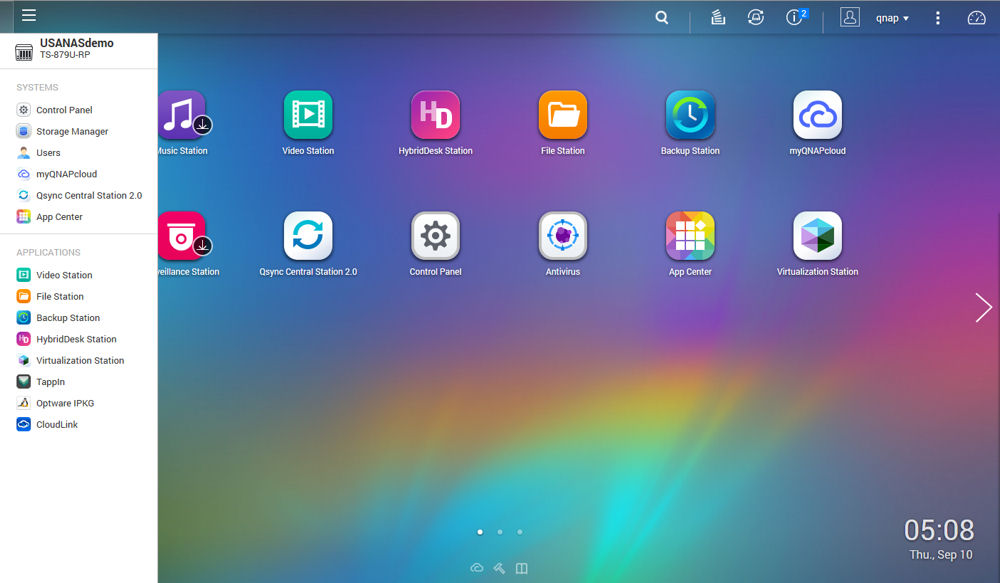
QNAP QTS 4.2 landing page
Performance
Firmware version 4.1.4 Build 20150820 was loaded onto the TS-131 and performance tests were run using the Revision 5 NAS test process. All tests were run using a WD Red 3 TB (WD30EFRX) (x1 SNB supplied).
If you filter the default NAS chart for a single drive and the Revision 5 testing method (black bars) you’ll see only four NASes. The composite image below shows File Copy Write Performance (left) and File Copy Read Performance (right). The QNAP TS-131 tops both charts with performance in excess of 100 MB/s

File Copy Write Performance (left) and File Copy Read Performance (right) filtered comparison
The Benchmark Summary shows the test results for all tests. In the composite image below, I’ve shown the QNAP TS-131 (left), the Synology DS115j (center) and the QNAP TS-112P (right). The Charts show the TS-131 outperformed the other two NASes for both Windows-based and NASPT-based write and read performance tests.
The Synology DS115j edged out the other two NASes for NASPT directory copy to and from NAS, for NASPT office productivity, for NASPT HD Playback & Record and for NASPT 4K HD Playback.
Surprisingly, the TS-112P had the best performance for iSCSI read from target. Backup to USB 3.0 Drive results are missing for the DS115j, as it only has USB 2.0 ports. Similarly, Backup to USB (2.0) Drive results are missing for the TS-131, is all three of its USB ports are USB 3.0.
Also note that the TS-131 dismounted our standard Startech SATA drive dock on multiple attempts shortly after starting our backup tests when connected via USB. So we ran the tests using a WD Passport USB drive. eSATA-connected backup tests ran fine.
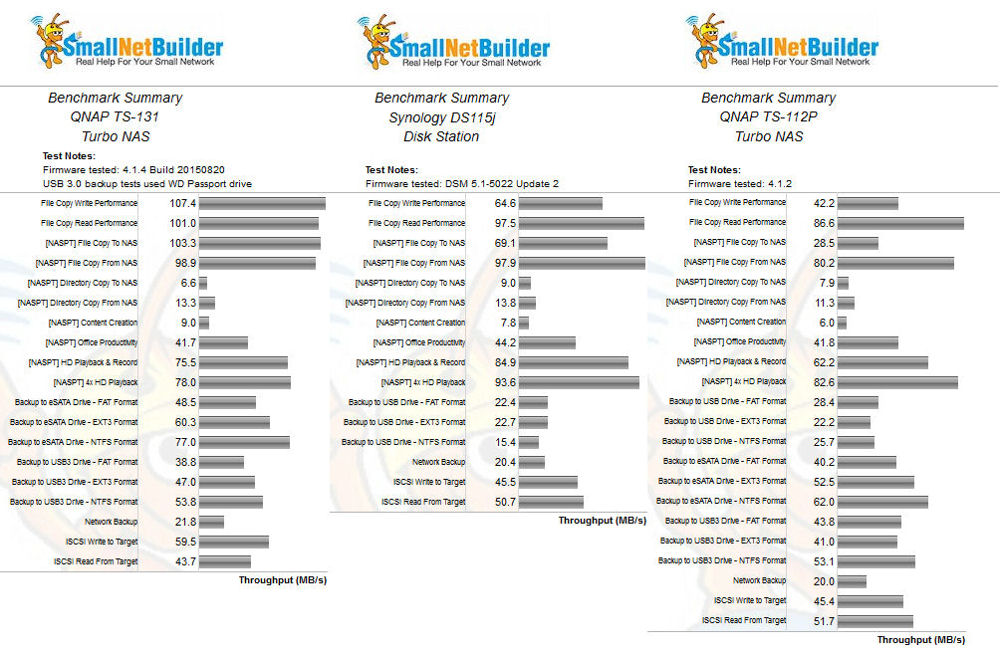
Benchmark summary comparison for the QNAP TS-131 (left), the Synology DS115j (center) and the QNAP TS-112P (right)
For NAS ranking, I filtered for NoRAID (to filter for single drive NASes) and Revision 5 testing. The QNAP TS-131 Turbo NAS narrowly edges out the Synology DS115j to earn a Ranked #1 award for NoRAID class NAS performance.
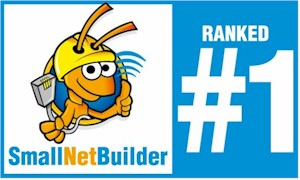
Drilling down into the performance of the three NASes allows us to look at individual and category comparisons. The composite chart below shows the detailed performance for the QNAP TS-131 (left), the Synology DS115j (center) and the QNAP TS-112P (right). The TS-131 held a clear and significant edge over the other two NASes for the Write Benchmark category. It tied with the category scores of the DS115j for Read Benchmarks, Mixed Read Write and for iSCSI.
As noted above in the Benchmark Summary comparison, the Synology DS115j grabbed the #1 category ranking for Video. The TS-112P won the iSCSI category, primarily due to the relatively slow iSCSI read tests on the TS-131. The individual iSCSI tests showed that the TS-131 had significantly faster iSCSI Write performance than the other two NASes.
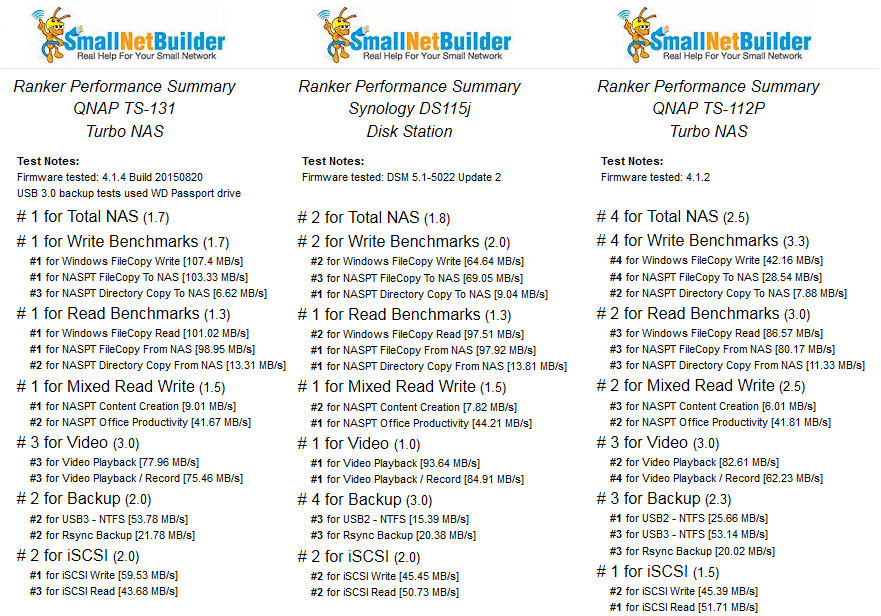
Ranker performance comparison for the QNAP TS-131 (left), the Synology DS115j (center) and the QNAP TS-112P (right)
Closing Thoughts
In the TS-112P review closing thoughts, we concluded that if USB 3.0 and eSATA ports are important, your only choice was the TS-112P because the Synology DS115j lacks both. But otherwise, the Synology was the clear performance winner.
That landscape has changed with the TS-131 because it has three USB 3.0 ports, an eSATA port and now tops the performance charts. Its write performance does, indeed, blow the other NASes away. But if you’re not planning on using USB or eSATA ports for backup, save some money and buy a larger drive for the Synology DS115j.![]()
